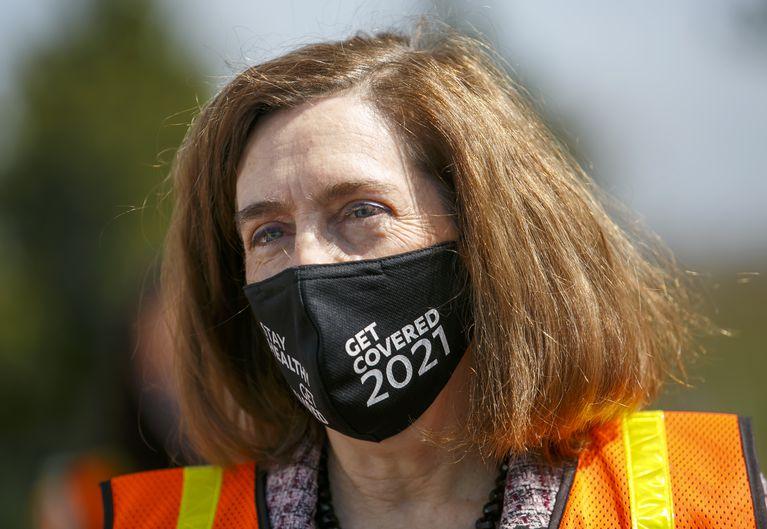
State officials on Thursday announced plans to ease up on COVID-19 mask requirements and lift the emergency declaration put in place to fight the pandemic.
Oregon’s mask requirement for indoor public places and schools will end on March 19, Oregon Health Authority officials said. Separately, Gov. Kate Brown is lifting the state’s COVID-19 emergency declaration effective April 1. The steps reflect an approach adopted by other states that seeks to manage COVID-19 with fewer restrictions as hospitalizations drop.
The health authority previously said the indoor mask requirement would end by March 31 or sooner if hospitalizations drop. By March 19, COVID-19 related hospitalizations are expected to drop by 400 or fewer, the state’s target.
Originally, the health authority announced plans to lift the indoor mask rule for public schools on March 31, but changed that based on feedback from school districts that they could make the transition sooner.
“We are able to take this important step, earlier than anticipated, because of the collective diligence and the shared sacrifice that people in Oregon have demonstrated in getting vaccinated, wearing masks and limiting their gatherings,” said Dr. Dean Sidelinger, the state health officer and state epidemiologist, in a statement.
A recent modeling report by Oregon Health & Science University projects the state would reach the hospitalization target around March 20. Daily COVID-19 hospitalizations have dropped 48% since peaking in late January during the omicron surge. During the past two weeks, hospitalizations have fallen by an average of more than 30 a day. On Wednesday, 579 people were hospitalized with COVID-19 across the state.
Reported COVID-19 infections also have dropped precipitously in recent weeks. Over the past month, new infections have declined by more than 80%. The seven-day moving average for new cases is 84% lower than at the peak of the Omicron surge.
The health authority and Oregon Department of Education will update safety protocols for quarantining, contact tracing and testing, said Colt Gill, director of the Oregon Department of Education and deputy superintendent of public instruction.
Despite the change, state officials still highly recommend that people in high-risk groups continue to wear masks in indoor public settings even after the restrictions are lifted. Those include unvaccinated people; people who are immunocompromised with underlying conditions; people 65 and older and people who live with anyone in those categories.
The governor’s emergency declaration that lifts on April 1 is not linked to masks, a requirement that went in place through separate state rules.
The state emergency declaration gave ORegon more flexibility for COVID-19 response and recovery efforts, such as allowing volunteer medical providers in hospitals through SERV-OR, the State Emergency Registry of Volunteers. The declaration also allowed Oregon to access federal disaster relief funds and provided flexibility for professional health licenses, such as out-of-state health professionals who work in hospitals.
Brown said Oregonians must remain vigilant because the pandemic is not over.
“Lifting Oregon’s COVID-19 emergency declaration today does not mean that the pandemic is over, or that COVID-19 is no longer a significant concern,” Brown said in a statement. “But, as we have shown through the Delta and Omicron surges, as we learn to live with this virus, and with so many Oregonians protected by safe and effective vaccines, we can now protect ourselves, our friends, and our families without invoking the extraordinary emergency authorities that were necessary at the beginning of the pandemic.”
For Oregonians, that means they should continue to get vaccinated and boosted, wear masks when necessary and stay home when sick, Brown said.
“That is the only way we can achieve our shared goals of saving lives and keeping our schools, businesses, and communities open,” Brown said.
You can reach Ben Botkin at [email protected] or via Twitter @BenBotkin1.